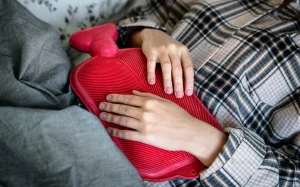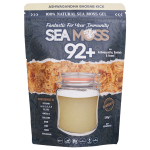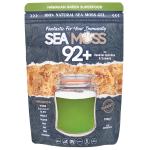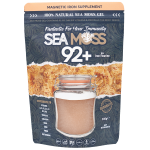PERIOD PAINS
PERIOD PAINS

Period pains, also known as dysmenorrhea, are common cramps experienced during menstruation. They occur because of the uterine contractions that help shed the uterine lining.
Symptoms include abdominal cramps, lower back pain, headaches, bloating, and mood changes. Primary dysmenorrhea refers to normal menstrual cramps, while secondary dysmenorrhea is caused by underlying conditions like endometriosis or uterine fibroids.
Treatment options include over-the-counter pain relievers, herbal remedies, hot compresses, and lifestyle changes. Certain foods, such as ginger, cinnamon, cranberries, raspberry leaf and herbs like evening primrose oil, can provide relief.
Adequate intake of vitamins and minerals like calcium, magnesium, and omega-3 fatty acids may also help alleviate period pains.
Description
Period pains, or dysmenorrhea, are common abdominal cramps experienced during menstruation. They result from the uterine contractions that occur as the uterus sheds its lining.
Symptoms can range from mild discomfort to severe cramping, along with lower back pain, headaches, bloating, and mood changes.
Treatment options include over-the-counter pain relievers, hormonal contraceptives, and heat therapy. Lifestyle changes like regular exercise and relaxation techniques can also help.
Certain foods and nutrients, such as ginger, turmeric, magnesium, omega-3 fatty acids, and vitamin E, may have anti-inflammatory properties and provide relief from period pains.
Menstrual cramps, also known as dysmenorrhea, can vary in severity and may include a range of symptoms. Some common symptoms associated with period pains include:
- Abdominal or Pelvic Pain: Many women experience a dull, throbbing, or cramping pain in the lower abdomen or pelvis during their menstrual period. This pain is often described as a heavy or squeezing sensation.
- Lower Back and Thigh Pain: Menstrual cramps can radiate to the lower back and thighs, causing discomfort and aching in these areas.
- Headache: Some women may experience headaches or migraines in conjunction with their menstrual cycle. Hormonal fluctuations are often associated with these headaches.
- Nausea: Nausea or queasiness can occur as a result of hormonal changes during menstruation. It may be accompanied by vomiting in some cases.
- Fatigue: Many women report feeling tired or fatigued during their menstrual period. Blood loss and hormonal changes can contribute to this feeling of fatigue.
- Dizziness: Hormonal fluctuations and blood loss can lead to feelings of dizziness or light-headedness in some individuals.
- Diarrhoea: Gastrointestinal symptoms like diarrhoea may accompany menstrual cramps in some women, possibly due to hormonal effects on the digestive system.
- Mood Changes: Some women may experience mood swings, irritability, or emotional changes before or during their period. This is often referred to as premenstrual syndrome (PMS).
There are two types of period pains:
- Primary Dysmenorrhea: This type of period pain occurs without any underlying medical condition. It is common among young women, usually beginning a year or two after they start menstruating. Primary dysmenorrhea is caused by the release of prostaglandins, which are hormone-like substances that cause the uterine muscles to contract. These contractions help expel the uterine lining during menstruation but can lead to pain and discomfort.
- Secondary Dysmenorrhea: This type of period pain is caused by an underlying medical condition, often related to the reproductive organs. Unlike primary dysmenorrhea, which usually starts during adolescence, secondary dysmenorrhea can occur later in life and may worsen over time.
Period pain, also known as dysmenorrhea, can have various underlying causes. Here are some common conditions that can contribute to menstrual cramps:
- Heavy Menstrual Flow (Menorrhagia): Excessive bleeding during menstruation can lead to more intense cramping as the uterus contracts to expel the excess blood.
- Endometriosis: This is a condition in which tissue similar to the uterine lining grows outside the uterus. It can cause severe pelvic pain, especially during menstruation.
- Uterine Fibroids: Noncancerous growths in the uterine wall, known as uterine fibroids, can lead to increased menstrual cramping and heavy bleeding.
- Pelvic Inflammatory Disease (PID): Infections in the reproductive organs, such as PID, can cause inflammation and pain, including during menstruation.
- Ovarian Cysts: Cysts on the ovaries, especially if they rupture or cause twisting of the ovary, can result in abdominal pain and discomfort during the menstrual cycle.
- Adenomyosis: Similar to endometriosis, adenomyosis involves the tissue that lines the uterus growing into the uterine muscle. This can lead to more intense menstrual cramps and heavy bleeding.
- Cervical Stenosis: In some cases, a narrow cervix can obstruct the flow of menstrual blood, causing increased pressure and cramping.
- Pelvic Congestion Syndrome: This condition involves the veins in the pelvis becoming enlarged and painful, leading to pelvic discomfort and pain during menstruation.
- IUD (Intrauterine Device): Some women may experience increased menstrual cramping as a side effect of having an IUD.
Medical treatment for period pain often involves the use of non-steroidal anti-inflammatory drugs (NSAIDs) and other pain relievers to help alleviate discomfort and reduce inflammation. Here are some common medications used for managing menstrual cramps:
- Ibuprofen (e.g., Brugesic): Ibuprofen is an NSAID that can help relieve pain and reduce inflammation. It is often used to alleviate menstrual cramps.
- Buscopan: This medication, also known as hyoscine butylbromide, is sometimes prescribed to ease uterine muscle spasms and reduce abdominal pain during menstruation.
- Diclofenac: Diclofenac is another NSAID that can be used to manage period pain by reducing inflammation and pain.
- Ketorolac/Naproxen: These are additional NSAIDs that may be prescribed or purchased over-the-counter to help alleviate menstrual cramps and associated pain.
Many individuals find relief from period pain through natural remedies and lifestyle modifications. Here are some natural treatment options that may help alleviate menstrual cramps:
- Evening Primrose Oil: Evening primrose oil is sometimes used to reduce the severity of menstrual cramps due to its potential anti-inflammatory properties. It contains gamma-linolenic acid (GLA), which may help regulate prostaglandin levels.
- Hot Compresses: Applying a warm compress or heating pad to the lower abdomen can help relax the uterine muscles and relieve pain. Heat therapy is a common and effective method for managing menstrual cramps.
- Hydration: Staying well-hydrated is important during your menstrual cycle. Proper hydration can help reduce bloating and alleviate some discomfort.
- Herbal Teas: Certain herbal teas, like ginger or chamomile tea, may have anti-inflammatory and soothing properties that can help ease menstrual cramps. Be sure to consult with a healthcare provider before using herbal remedies, especially if you have any underlying health conditions.
- Meditation: Mindfulness meditation and relaxation techniques can help reduce stress and muscle tension, which may contribute to the relief of period pain.
- Yoga: Gentle yoga poses and stretches can promote relaxation, improve blood circulation, and reduce muscle cramps. Specific yoga poses, such as child's pose and cobra pose, can be particularly helpful for menstrual discomfort.
- Regular Exercise: Engaging in regular physical activity throughout the month can help reduce the severity of menstrual cramps. Exercise releases endorphins, which are natural pain relievers.










